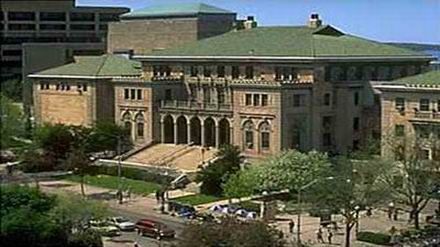第一篇:
地质学,讲的是大气如何形成
(注:此篇可结合TPO16的第三篇Planets in our solar system中与大气相关内容阅读)
Atmosphere
Atmosphere, mixture of gases surrounding any celestial object that has a gravitational field strong enough to prevent the gases from escaping; especially the gaseous envelope of Earth. The principal constituents of the atmosphere of Earth are nitrogen (78 percent) and oxygen (21 percent). The atmospheric gases in the remaining 1 percent are argon (0.9 percent), carbon dioxide (0.03 percent), varying amounts of water vapor, and trace amounts of hydrogen, ozone, methane, carbon monoxide, helium, neon, krypton, and xenon.
The mixture of gases in the air today has had 4.5 billion years in which to evolve. The earliest atmosphere must have consisted of volcanic emanations alone. Gases that erupt from volcanoes today, however, are mostly a mixture of water vapor, carbon dioxide, sulfur dioxide, and nitrogen, with almost no oxygen. If this is the same mixture that existed in the early atmosphere, then various processes would have had to operate to produce the mixture we have today. One of these processes was condensation. As it cooled, much of the volcanic water vapor condensed to fill the earliest oceans. Chemical reactions would also have occurred. Some carbon dioxide would have reacted with the rocks of Earth’s crust to form carbonate minerals, and some would have become dissolved in the new oceans. Later, as primitive life capable of photosynthesis evolved in the oceans, new marine organisms began producing oxygen. Almost all the free oxygen in the air today is believed to have formed by photosynthetic combination of carbon dioxide with water. About 570 million years ago, the oxygen content of the atmosphere and oceans became high enough to permit marine life capable of respiration. Later, some 400 million years ago, the atmosphere contained enough oxygen for the evolution of air-breathing land animals.
The water-vapor content of the air varies considerably, depending on the temperature and relative humidity. With 100 percent relative humidity, the water-vapor content of air varies from 190 parts per million (ppm) at -40°C (-40°F) to 42,000 ppm at 30°C (86°F). Minute quantities of other gases, such as ammonia, hydrogen sulfide, and oxides of sulfur and nitrogen, are temporary constituents of the atmosphere in the vicinity of volcanoes and are washed out of the air by rain or snow. Oxides and other pollutants added to the atmosphere by industrial plants and motor vehicles have become a major concern, however, because of their damaging effects in the form of acid rain. In addition, the strong possibility exists that the steady increase in atmospheric carbon dioxide, mainly as the result of the burning of fossil fuels since the mid-1800s, may affect Earth’s climate (see Greenhouse Effect).
Similar concerns are posed by the sharp increase in atmospheric methane. Methane levels have risen 11 percent since 1978. About 80 percent of the gas is produced by decomposition in rice paddies, swamps, and the intestines of grazing animals, and by tropical termites. Human activities that tend to accelerate these processes include raising more livestock and growing more rice. Besides adding to the greenhouse effect, methane reduces the volume of atmospheric hydroxyl ions, thereby curtailing the atmosphere’s ability to cleanse itself of pollutants. See also Air Pollution; Climate; Smog.
The study of air samples shows that up to at least 88 km (55 mi) above sea level the composition of the atmosphere is substantially the same as at ground level; the continuous stirring produced by atmospheric currents counteracts the tendency of the heavier gases to settle below the lighter ones. In the lower atmosphere, ozone, a form of oxygen with three atoms in each molecule, is normally present in extremely low concentrations. The layer of atmosphere from 19 to 48 km (12 to 30 mi) up contains more ozone, produced by the action of ultraviolet radiation from the sun. Even in this layer, however, the percentage of ozone is only 0.001 by volume. Atmospheric disturbances and downdrafts carry varying amounts of this ozone to the surface of Earth. Human activity adds to ozone in the lower atmosphere, where it becomes a pollutant that can cause extensive crop damage.
The ozone layer became a subject of concern in the early 1970s, when it was found that chemicals known as chlorofluorocarbons (CFCs), or chlorofluoromethanes, were rising into the atmosphere in large quantities because of their use as refrigerants and as propellants in aerosol dispensers. The concern centered on the possibility that these compounds, through the action of sunlight, could chemically attack and destroy stratospheric ozone, which protects Earth’s surface from excessive ultraviolet radiation. As a result, industries in the United States, Europe, and Japan replaced chlorofluorocarbons in all but essential uses. See Aerosol Dispenser; Ozone Layer; Photochemistry.
The atmosphere may be divided into several layers. In the lowest one, the troposphere, the temperature as a rule decreases upward at the rate of 5.5°C per 1,000 m (3°F per 3,000 ft). This is the layer in which most clouds occur (see Cloud). The troposphere extends up to about 16 km (about 10 mi) in tropical regions (to a temperature of about -79°C, or about -110°F) and to about 9.7 km (about 6 mi) in temperate latitudes (to a temperature of about -51°C, or about -60°F). Above the troposphere is the stratosphere. In the lower stratosphere the temperature is practically constant or increases slightly with altitude, especially over tropical regions. Within the ozone layer the temperature rises more rapidly, and the temperature at the upper boundary of the stratosphere, almost 50 km (about 30 mi) above sea level, is about the same as the temperature at the surface of Earth. The layer from 50 to 90 km (30 to 55 mi), called the mesosphere, is characterized by a marked decrease in temperature as the altitude increases.
From investigations of the propagation and reflection of radio waves, it is known that beginning at an altitude of 60 km (40 mi), ultraviolet radiation, X rays (see X Ray), and showers of electrons from the sun ionize several layers of the atmosphere, causing them to conduct electricity; these layers reflect radio waves of certain frequencies back to Earth. Because of the relatively high concentration of ions in the air above 60 km (40 mi), this layer, extending to an altitude of about 1000 km (600 mi), is called the ionosphere. At an altitude of about 90 km (55 mi), temperatures begin to rise. The layer that begins at this altitude is called the thermosphere, because of the high temperatures reached in this layer (about 1200°C, or about 2200°F). The region beyond the thermosphere is called the exosphere, which extends to about 9,600 km (about 6,000 mi), the outer limit of the atmosphere.
The density of dry air at sea level is about 1/800 the density of water; at higher altitudes it decreases rapidly, being proportional to the pressure and inversely proportional to the temperature. Pressure is measured by a barometer and is expressed in millibars, which are related to the height of a column of mercury that the air pressure will support; 1 millibar equals 0.75 mm (0.03 in) of mercury. Normal atmospheric pressure at sea level is 1,013 millibars, that is, 760 mm (29.92 in) of mercury. At an altitude of 5.6 km (about 3.5 mi) pressure falls to about 507 millibars (about 380 mm/14.96 in of mercury); half of all the air in the atmosphere lies below this level. The pressure is approximately halved for each additional increase of 5.6 km in altitude. At 80 km (50 mi) the pressure is 0.009 millibars (0.0069 mm/0.00027 in of mercury).





 湘公网安备 43011102001150号
湘公网安备 43011102001150号

